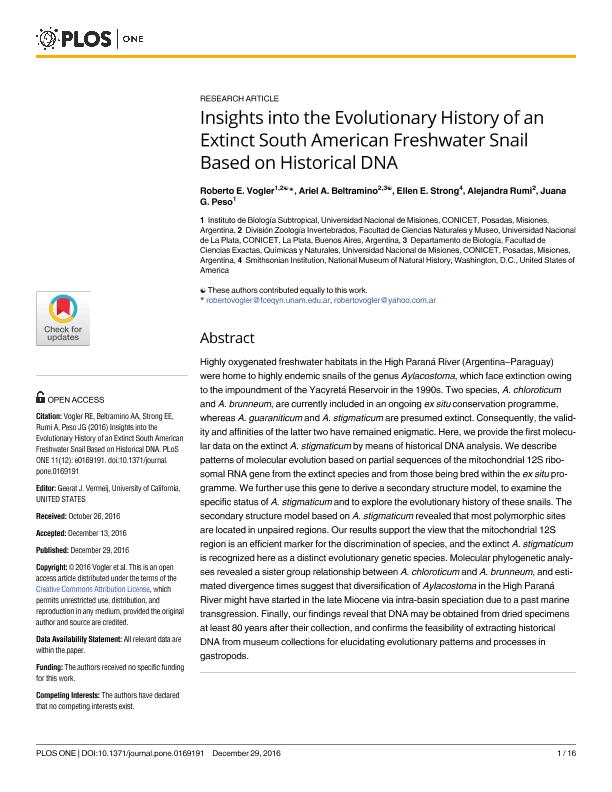Mostrar el registro sencillo del ítem
dc.contributor.author
Vogler, Roberto Eugenio

dc.contributor.author
Beltramino, Ariel Anibal

dc.contributor.author
Strong, Ellen E.
dc.contributor.author
Rumi Macchi Z., Alejandra

dc.contributor.author
Peso, Juana Guadalupe

dc.date.available
2018-05-07T21:01:15Z
dc.date.issued
2016-12
dc.identifier.citation
Vogler, Roberto Eugenio; Beltramino, Ariel Anibal; Strong, Ellen E.; Rumi Macchi Z., Alejandra; Peso, Juana Guadalupe; Insights into the Evolutionary History of an Extinct South American Freshwater Snail based on Historical DNA; Public Library of Science; Plos One; 11; 12; 12-2016; 1-16; e0169191
dc.identifier.issn
1932-6203
dc.identifier.uri
http://hdl.handle.net/11336/44377
dc.description.abstract
Highly oxygenated freshwater habitats in the High Paraná River (Argentina–Paraguay) were home to highly endemic snails of the genus Aylacostoma, which face extinction owing to the impoundment of the Yacyretá Reservoir in the 1990s. Two species, A. chloroticum and A. brunneum, are currently included in an ongoing ex situ conservation programme, whereas A. guaraniticum and A. stigmaticum are presumed extinct. Consequently, the validity and affinities of the latter two have remained enigmatic. Here, we provide the first molecular data on the extinct A. stigmaticum by means of historical DNA analysis. We describe patterns of molecular evolution based on partial sequences of the mitochondrial 12S ribosomal RNA gene from the extinct species and from those being bred within the ex situ programme. We further use this gene to derive a secondary structure model, to examine the specific status of A. stigmaticum and to explore the evolutionary history of these snails. The secondary structure model based on A. stigmaticum revealed that most polymorphic sites are located in unpaired regions. Our results support the view that the mitochondrial 12S region is an efficient marker for the discrimination of species, and the extinct A. stigmaticum is recognized here as a distinct evolutionary genetic species. Molecular phylogenetic analyses revealed a sister group relationship between A. chloroticum and A. brunneum, and estimated divergence times suggest that diversification of Aylacostoma in the High Paraná River might have started in the late Miocene via intra-basin speciation due to a past marine transgression. Finally, our findings reveal that DNA may be obtained from dried specimens at least 80 years after their collection, and confirms the feasibility of extracting historical DNA from museum collections for elucidating evolutionary patterns and processes in gastropods.
dc.format
application/pdf
dc.language.iso
eng
dc.publisher
Public Library of Science

dc.rights
info:eu-repo/semantics/openAccess
dc.rights.uri
https://creativecommons.org/licenses/by-nc-sa/2.5/ar/
dc.subject
12s Rrna Gene
dc.subject
Abgd
dc.subject
Aylacostoma
dc.subject
High Parana River
dc.subject
K/Theta Method
dc.subject
Secondary Structure
dc.subject
Thiaridae
dc.subject.classification
Otras Ciencias Biológicas

dc.subject.classification
Ciencias Biológicas

dc.subject.classification
CIENCIAS NATURALES Y EXACTAS

dc.title
Insights into the Evolutionary History of an Extinct South American Freshwater Snail based on Historical DNA
dc.type
info:eu-repo/semantics/article
dc.type
info:ar-repo/semantics/artículo
dc.type
info:eu-repo/semantics/publishedVersion
dc.date.updated
2018-05-04T20:16:37Z
dc.journal.volume
11
dc.journal.number
12
dc.journal.pagination
1-16; e0169191
dc.journal.pais
Estados Unidos

dc.journal.ciudad
San Francisco
dc.description.fil
Fil: Vogler, Roberto Eugenio. Consejo Nacional de Investigaciones Científicas y Técnicas. Centro Científico Tecnológico Conicet - Nordeste. Instituto de Biología Subtropical. Instituto de Biología Subtropical - Nodo Posadas | Universidad Nacional de Misiones. Instituto de Biología Subtropical. Instituto de Biología Subtropical - Nodo Posadas; Argentina. Universidad Nacional de La Plata. Facultad de Ciencias Naturales y Museo. División de Zoología Invertebrados; Argentina
dc.description.fil
Fil: Beltramino, Ariel Anibal. Universidad Nacional de La Plata. Facultad de Ciencias Naturales y Museo. División de Zoología Invertebrados; Argentina. Universidad Nacional de Misiones. Facultad de Ciencias Exactas Químicas y Naturales. Departamento de Biología; Argentina. Consejo Nacional de Investigaciones Científicas y Técnicas; Argentina
dc.description.fil
Fil: Strong, Ellen E.. National Museum of Natural History; Estados Unidos
dc.description.fil
Fil: Rumi Macchi Z., Alejandra. Universidad Nacional de La Plata. Facultad de Ciencias Naturales y Museo. División de Zoología Invertebrados; Argentina. Consejo Nacional de Investigaciones Científicas y Técnicas; Argentina
dc.description.fil
Fil: Peso, Juana Guadalupe. Consejo Nacional de Investigaciones Científicas y Técnicas. Centro Científico Tecnológico Conicet - Nordeste. Instituto de Biología Subtropical. Instituto de Biología Subtropical - Nodo Posadas | Universidad Nacional de Misiones. Instituto de Biología Subtropical. Instituto de Biología Subtropical - Nodo Posadas; Argentina
dc.journal.title
Plos One

dc.relation.alternativeid
info:eu-repo/semantics/altIdentifier/doi/http://dx.doi.org/10.1371/journal.pone.0169191
dc.relation.alternativeid
info:eu-repo/semantics/altIdentifier/url/http://journals.plos.org/plosone/article?id=10.1371/journal.pone.0169191
Archivos asociados
